|
In March, the Evidence and Learning Team in the Center for Democracy, Human Rights, and Governance (DRG) was pleased to organize the 2022 DRG Learning Forum. Across the four virtual sessions, worldwide more than 500 participants from USAID, implementing partners, and other colleagues engaged with academics and practitioners to discuss current evidence and key programming implications.
This edition of the DRG Learning Digest examines the following four topics that were the focus of this year’s Forum:
-
Gender equity supports sustainable democracy. In a survey experiment, citizens had improved perceptions of government trustworthiness and performance when presented with female leaders. Building on the DRG Center’s Women in Power research and Gender Integration in DRG Programming Toolkit, a growing library of new women’s political participation and leadership (WPPL) resources offers a structured way to analyze the factors that inhibit and facilitate women’s participation so as to design effective programs. The WPPL Assessment Framework—which includes a desk review, general population survey, politician survey, key informant interviews, and focus group discussions—is currently being piloted in four countries and will soon be available for USAID Missions worldwide.
-
A social and behavior change (SBC) approach can help rule of law and justice sector programming shift norms and create a culture of justice. The SBC Primer details a model to inform programming design and implementation. Examples from a global review of rule of law achievements, the Democratic Republic of Congo, and Kosovo, provide evidence that a SBC approach can encourage citizens to engage with the justice sector and other governing institutions.
-
While autocrats have learned how to use digital tools to target opposition and reduce regime defection, activists are resiliently adapting with technical and behavioral changes. Autocracies with differing levels of digital capacity employ a variety of technology-based tactics. In response, both activists and DRG program designers are learning and making technical and behavioral adaptations.
-
The DRG evidence base is growing exponentially. Dissemination of that evidence is improving, but uptake remains variable. Evidence in the DRG sector has increased exponentially, from a handful of impact evaluations and systematic reviews in 2000 to approximately 1,500 today. (Check out the DRG evidence gap maps on the DRG Learning, Evidence, and Analysis Platform to see useful compendia of this evidence!) Nonetheless, the most common types of evidence in use are experiential and contextual; research evidence usage remains relatively low. While dissemination practices have improved, easy and timely access to research evidence, as well as tailored findings and recommendations remain critical to support uptake and application of evidence.
Please make use of DRG Evidence and Learning Team resources! (See text box at the end.)
Supporting Effective Women’s Political Empowerment: An Evidence-Based Approach
Women’s political representation matters to sustainable democracy. Professor Amanda Clayton from Vanderbilt University discussed the strategic importance of public trust in democracy and the role of women’s political leadership. Recent survey data indicates that voters tend to perceive female politicians as having more integrity than men; when lawmakers are viewed by citizens as being both trustworthy and representative of the community, democracies are more sustainable.
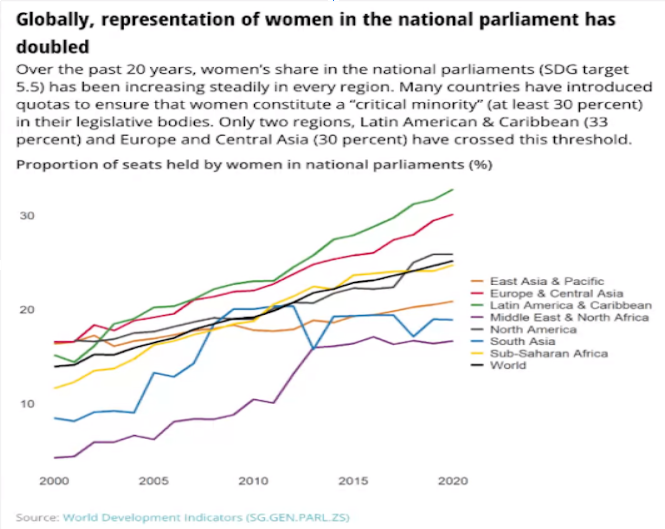 Women’s political representation is increasing worldwide. Source: World Development Indicators and Amanda Clayton, Vanderbilt University.
How can we leverage data to improve gender inclusion in politics? Zoe Grotophorst, from NORC at the University of Chicago, outlined the growing library of tools used to identify key challenges and opportunities for WPPL. Using the WPPL Assessment Framework under development by the Evidence and Learning Team, we can better diagnose and understand gender gaps in the countries where USAID works, especially as they relate to social and cultural norms. Ms. Grotophorst shared key results of pilot surveys ongoing in Guatemala, Guinea, Liberia, and Nepal, and presented strategies for country-specific customization of assessments to develop richer and more representative datasets while still allowing for cross-national comparison.
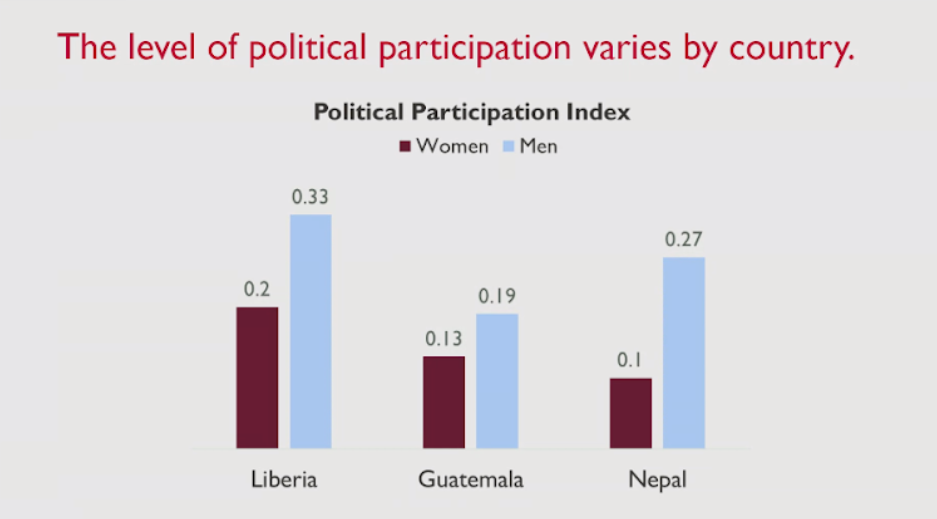 The varying levels of political participation by men and women in the WPPL pilot surveys. Source: Zoe Grotophorst, NORC at the University of Chicago.
How can we use the WPPL Assessment Framework in our DRG programming? Alpha Luyoyo, from USAID/Guinea, described how the Mission has been conducting a WPPL assessment to generate data to inform advocacy efforts to encourage more female participation in upcoming elections. Julie Denham, from the Democratic Elections and Political Processes Team in the USAID DRG Center, also provided an update on U.S. policy support for women’s political participation and leadership, including through the Summit for Democracy’s Presidential Initiative for Democratic Renewal (PIDR). The PIDR includes the Advancing Women’s and Girls’ Civic and Political Leadership Initiative, which will address individual, structural, and sociocultural barriers to women’s participation via a holistic program approach. USAID will use the WPPL assessment tool to identify gaps, key stakeholders, and programming opportunities in up to ten focus countries under this new initiative.
Want to find out more about these topics? Please watch the session recording and peruse the presentations.
Culture of Justice: A Case for Social and Behavior Change (SBC)
How do we accomplish social change in a society’s culture of justice? Golnoosh Hakimdavar, from the Evidence and Learning Team in the DRG Center, presented preliminary findings from an ongoing global review of USAID’s concrete and sustained rule of law (ROL) achievements since 2005. This review found that integrating ROL into a society’s values and institutions requires gradual, long-term adjustments in behavior, relationships, and culture. Agathe Tshimpanga, from USAID/Democratic Republic of the Congo (DRC), described how the Mission is utilizing political economy and social norms analyses. The challenge is that the perception of the justice system is so unfavorable that even efforts toward improvement are often dismissed by a skeptical public that has lost trust in those institutions. As a result, the Mission is integrating a five-month analysis into the activity design and procurement process to understand the social norms around justice so that upcoming programming can improve the justice system and people’s trust and willingness to engage with that system. Laura Van Berkel, from Democracy International, also shared how an ongoing social contract activity in Kosovo—another country in which the public’s trust in government is low—is using a SBC lens to encourage citizens to participate in public meetings where they can have a say in local governance. By gathering data to identify the behavioral barriers to engagement, a SBC approach can address those individual, social, or structural barriers to create effective and self-sustaining change, encouraging citizens to participate in their local community.
What resources exist to support SBC approaches? Levi Adelman, from the Evidence and Learning Team in the DRG Center, provided an overview of the benefits of using SBC when designing DRG activities. Identifying the psychological and social determinants behind certain behaviors can help USAID build more effective justice systems that take human behavior into account.
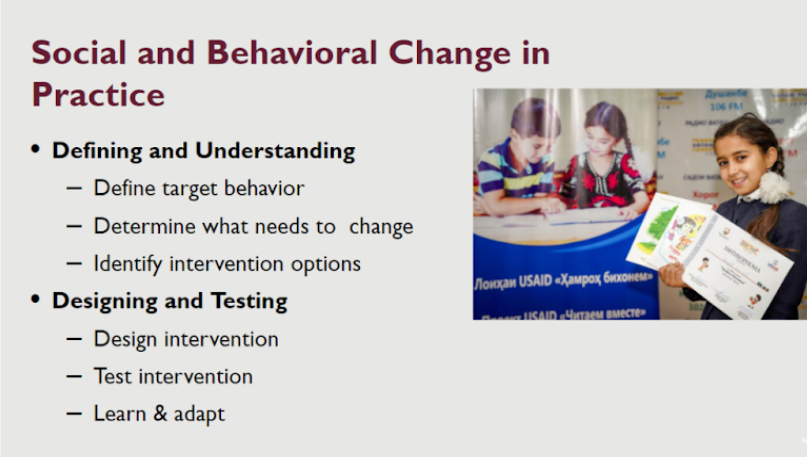 The key steps to integrating a SBC approach in programming design. Source: SBC Primer.
Want to find out more about these topics? Please watch the session recording and review the presentations.
Countering Authoritarianism in the Digital Realm: Challenges and Opportunities
How have autocrats learned to employ digital tools? Our optimism about the uses of technology to advance democracy, human rights, and good governance has been tempered by deep concerns about its deleterious effects. Drawing on a recent literature review, Professor Erica Frantz from Michigan State University outlined the types of tools, techniques, and tactics that authoritarian regimes use to expand their control and repression. Digital tools can enable dictatorships to engage in high-intensity, targeted repression, decreasing citizens' ability to claim their rights to freedom of expression and association. By making it more difficult for citizens to express dissent—including through organized protests—these tools can enhance authoritarian durability.
How are DRG practitioners adapting to these challenges? Jonathan Pinckney, from the United States Institute of Peace (USIP), shared findings from two Special Reports (July 2021 and February 2022). He described a recurring cycle in which civil rights activists and authoritarian governments continually react and adapt to each other’s use of technology. Activists are employing a range of technical and behavioral adaptations in response to these developments. He also provided recommendations including addressing inequities in access to advanced training, facilitating learning through transnational activist networks, and universal integration of a digital approach to civil society support.
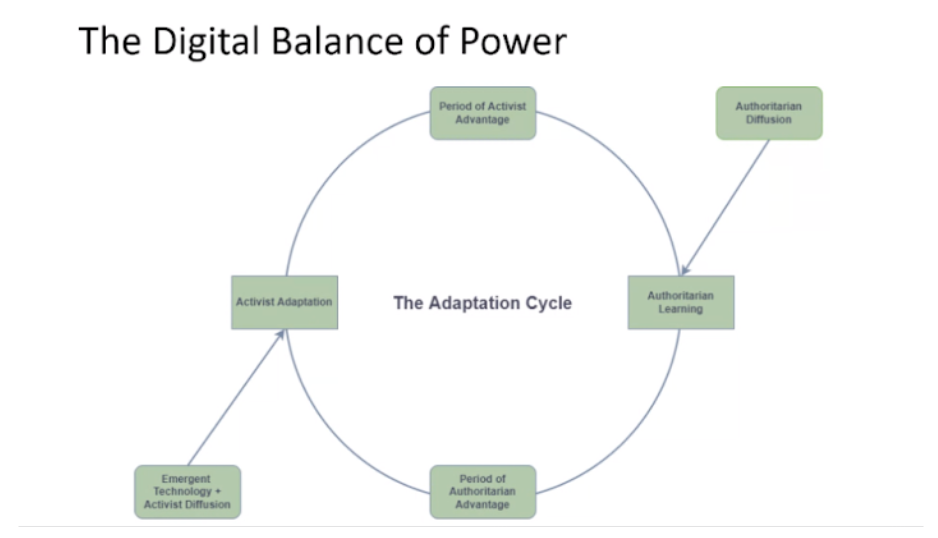 Activists and autocrats continually adapt to each other’s use of new technologies. Source: Jonathan Pinckney, USIP.
Want to find out more about these topics? Please watch the session recording and peruse the presentations.
Amplifying Evidence in DRG Programming
How is evidence currently used in DRG programming? There is a growing body of DRG evidence that we can leverage in our programming. According to the Agency evaluation registry, in the DRG sector alone between 2016-2020, more than 170 external evaluations were conducted. Beyond our own USAID products, a recent exercise to identify high-quality research uncovered around 1,500 impact evaluations and systematic reviews testing the effects of DRG interventions on a wide range of outcomes. These sources are curated in an easily searchable format as part of six evidence gap maps on Rule of Law, Human Rights, Civil Society, Media and Information, Governance, and Democratic Elections and Political Processes.
 Aleta Starosta and Robert Gerstein, from The Cloudburst Group, presented preliminary findings from the Evidence and Learning Team’s ongoing study that is examining how USAID Missions use research evidence (broadly defined) to inform DRG activity designs. Based on a survey of over 80 USAID staff involved in recent activity designs, the most commonly cited uses of evidence were experiential evidence (e.g., lessons learned, after action reviews) and contextual evidence (e.g., assessments, political economy analyses), with only around two out of every five respondents noting that research evidence (e.g., impact evaluations, academic research) had a significant influence on activity design. Primary barriers to the greater use of research evidence included a lower prioritization and a lack of time, followed by challenges in locating, synthesizing, and applying such evidence. Respondents’ top recommendations to address these barriers included a research evidence help desk and a website that curated evidence. Regarding the latter, see the DRG evidence gap maps featured on the DRG LEAP (Learning, Evidence, and Analysis Platform) under “Access the Maps.”
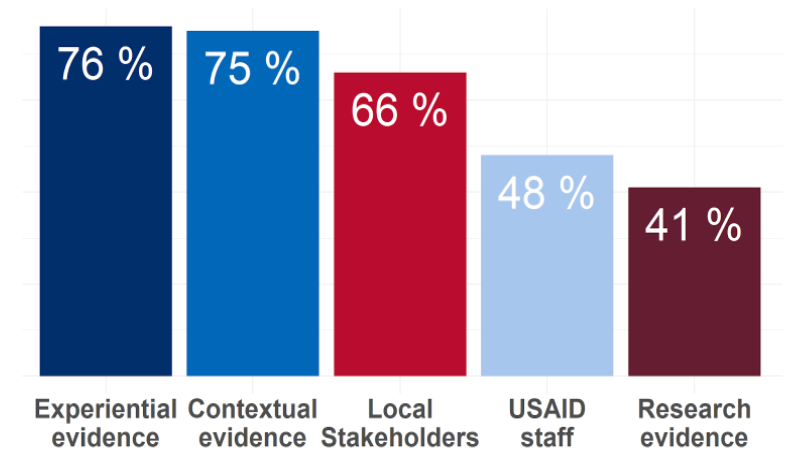 Factors that had a significant influence on recent DRG activity designs (n=83). Source: The Cloudburst Group.
How do we ensure the growing body of DRG evidence informs our programming? In a joint presentation, Ben Morse, from Social Impact, and Miriam Counterman, from The Cloudburst Group, shared findings from two parallel Evidence and Learning Team studies on a sample of how more than 50 USAID-commissioned DRG learning products (evaluations, assessments, etc.) have been used to inform decision-making. They noted several barriers to use, including limited bandwidth, resource constraints, and staff turnover. On the positive side, they found that all successful utilization cases entailed key stakeholder engagement throughout the research process rather than only after the findings were released. The studies recommended incorporating robust dissemination plans into Statements of Work and contractual agreements, prioritizing short, digestible infographics and two-pagers targeted to specific audiences, translating dissemination materials into local languages, and developing action plans regarding how learning will be used.
Want to find out more about these topics? Please watch the session recording and review the presentations.
At next year’s DRG Learning Forum we plan to present the results of new research currently underway to support the 2021-2023 DRG Learning Agenda, which in turn supports the new 2022-2026 Agency Learning Agenda! Stay tuned and we look forward to you joining us next year!
Welcome to the DRG Learning Digest, a newsletter to keep you informed of the latest learning, evaluation, and research in the Democracy, Human Rights and Governance (DRG) sector. Views expressed in the external (non-USAID) publications linked in this Digest do not necessarily represent the views of the United States Agency for International Development or the United States Government.
Don't forget to check out our DRG Learning Menu of Services! (Link only accessible to USAID personnel.) The Menu provides information on the learning products and services the Evidence and Learning Team offers to help you fulfill your DRG learning needs. We want to help you adopt learning approaches that emphasize best fit and quality.
The Evidence and Learning Team is also excited to share our DRG Learning, Evidence, and Analysis Platform (LEAP) with you. This Platform contains inventories of programmatic approaches and indicators, evidence gap maps, and data portraits - all of which can be very useful in DRG activity design, implementation, evaluation, and adaptation. Some of these resources are still being built, so check back frequently to see what has been newly added.
We also want to share our DRG Learning Harvest with you! (Link only accessible to USAID personnel.) This is a searchable database of DRG learning products, including summaries of key findings and recommendations, drop-down menus to easily find documents related to a particular country or program area, and links to the full reports on the DEC.
Our friends at the Varieties of Democracy (V-Dem) Institute are also seeking to expand their research partnership with USAID on the complex nature of democracy by inviting research questions from you for V-Dem to work on. If there's a DRG technical question you've been wondering about, please email the Evidence and Learning Team at ddi.drg.elmaillist@usaid.gov.
We welcome your feedback on this newsletter and on our efforts to promote the accessibility, dissemination, and utilization of DRG evidence and research. Please visit the DRG Center's website for additional information or contact us at ddi.drg.elmaillist@usaid.gov.
|